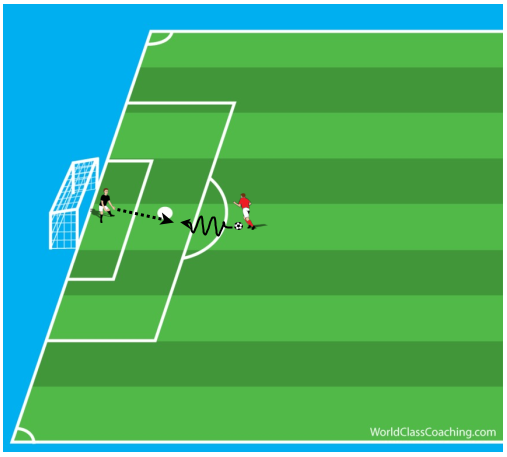By Tony Englund -
When I give goalkeeper training sessions to coaches, many ask about teaching their goalkeepers to deal with break-aways. In the first of a two-part article on the subject, we looked at building the goalkeeper’s confidence in blocking and closing down. In this second portion, tips for dealing with the break-away situation in match-like situations will be shared.

Break-Aways – Straight On The attacker starts his run from 25 yards before goal. To begin with, all break-ways are straight on to goal to simplify the work for the goalkeeper. The attacker must go at full speed and cannot shoot, but must try to beat the goalkeeper on the dribble. Encourage the goalkeeper to close quickly, but under control and look for a longer touch (or for the ball to be underneath the attacker, in his feet) and to take that cue to cover the ball. The goalkeeper must try to get control of the situation by being aggressive and taking away the attacker’s options through getting tight to the ball well away from goal.
[wpsharely id="821"][/wpsharely]Progression
- The attacker can shoot or dribble. Now the goalkeeper must watch for cues that the attacker will shoot (eyes up, longer touch, leg back-swing) and get his feet set to save.
- Add a chasing defender. This is an important consideration. The attacker starts from 30 yards in front of goal. The defender starts 4 yards further away from goal and tries to catch the attacker and stop the ball. The goalkeeper must allow the defender to try to stop the attacker while beginning to close down. If the defender cannot get even (shoulder-to shoulder) with the attacker when the ball enters the 18-yard box, the goalkeeper must treat the situation as a break-away and close down.
Break-Aways – All angles. The attackers try different angles now to see if they can get the goalkeeper to open up some of the goal on the break-away. For the goalkeeper, there are additional considerations with a wide-angle attack:
- The goalkeeper must always protect the near post while understanding that the attacker is trained to finish low to the back post. Therefore if the goalkeeper adopts a position that is about ½ step further toward the back post than normal and closes down, the attacker may be tempted to work in the near post area, which dramatically shrinks the amount of the goal that the goalkeeper has to defend.
- If the attacker takes a dribbling touch toward the near post while the goalkeeper is near, the ‘keeper should use that moment to become more aggressive and try to win the ball.
By Tony Englund - Holds an NSCAA Premier License and 11 other diplomas. Tony has presented goalkeeping clinics for the NSCAA and is the author of six books including: Goalie Wars! and Art of the Duel



